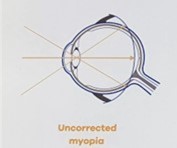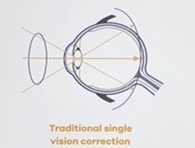Myopia Control: Shaping the Future of Clear Vision
Clear Vision is a precious gift that allows us to explore the world around us. However, for a growing number of people, a condition called myopia, commonly known as nearsightedness, can gradually diminish this gift. Over the past decade, myopic control has emerged as an innovative approach to slow down the progression of nearsightedness and preserve a person’s visual health. Over the next few blog posts, we will explore the concept of myopia control, its significance, and some effective techniques used to manage this condition.
What is Myopia?
Myopia (nearsightedness) is usually when the eyeball is longer than normal, causing the world we see to be focused in front of the retina, instead of directly on it. This makes distant objects appear blurry, while near objects remain clear.

The exact cause of myopia is not fully understood, but the consensus is there is a genetic and/or environmental component to it. It typically develops during childhood (after 6 years old) or adolescence and can gradually get worse into adulthood, stopping usually around our early to mid-20s. There is a free tool online that assesses the risk of myopia progression in children, give it a try: My Kids Vision
In recent years, myopia has reached alarming levels, especially among children and young adults. It is estimated that nearly half of the world’s population will be nearsighted by 2050. This trend is concerning because high myopia is associated with an increased risk of sight-threatening conditions, such as retinal detachments, glaucoma, and macular degeneration to name a few.
The Importance of Myopia Control:
Traditionally, myopia was corrected with eyeglasses or contact lenses to help focus light directly on our eyes, however that doesn’t seem to be enough anymore. Given the potential long-term complications associated with high myopia, the concept of myopia control has gained significant attention in the field of optometry. Myopia control strategies aim to slow down the progression of nearsightedness, thereby reducing the risk of developing severe visual complications later in life. It offers a proactive approach to managing myopia and preserving visual health for the future.

Techniques used to Control Myopia:
There are several techniques that have been developed that are effective in controlling the progression of myopia. Listed below are the most common and effective techniques available. In future blogs we will go into more detail on how each technique works, and the pros and cons of each one.
- Ortho-keratology (Ortho-k): This procedure involves wearing a rigid contact lens overnight to reshape the cornea and reduce the length of the eyeball. Similar to a retainer for the teeth, to keep the teeth straight. The lens provides a temporary correction of myopia, providing clear vision during the daytime.
- Peripheral defocusing lenses – uniquely designed eyeglass lenses and contact lenses, manipulate the periphery light entering the eye to match the shape of the back of the eyeball. This design helps slow down the eyeball from stretching, there by slowing down nearsighted progression.
- Medicated eye drops – we use low-dose Atropine to relax the focusing muscles in the eye to help reduce eye elongation.
- Visual hygiene and outdoor time – spending more time outdoors and less time on near tasks (i.e. digital screens) have shown to reduce myopia development.
Remember, your eyes are invaluable, if you are concerned about myopia progression in your children, please make an appointment with your Optometrist to find an option that best suits them.
Can’t wait for the next blog, and would like more information? Feel free to reach out to me at k.lee@trinityhillseyecare.ca


